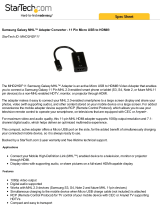
Smart Features
Smart Hub
37 Launching Smart Hub automatically
38 Testing Smart Hub connections
38 Using the Smart Hub tutorial
38 Resetting Smart Hub
Using Smart Hub with a Samsung Account
39 Creating a Samsung account
40 Signing in to a Samsung account
40 Linking your Samsung account to external service
accounts
41 Changing and adding information to a Samsung
account
41 Deleting all Samsung accounts from the TV
Using the SAMSUNG APPS Service
42 Managing Downloaded Apps with the pop-up Options
menu
43 Installing an app
44 Removing an app from the TV
44 Locking and unlocking apps
44 Updating apps
44 Rearranging apps
44 Rating purchased apps
44 Using other app features and functions
Using the e-Manual
45 Launching the e-Manual
45 Using the buttons in the e-Manual
Using the web browser
46 Browsing preferences
Using the MY CONTENT Service
48 Read before playing media content
49 Playing multimedia content in a computer or mobile
device
49 Playing media content saved on a USB device
50 Buttons and functions available while viewing photos
51 Buttons and functions available while viewing videos
53 Buttons and functions available while playing music
53 Listening to music in HD quality
54 Functions on the media content list screen
54 Resetting All Sound Settings
Using the NewsON Service
55 News
55 Weather
TV Viewing
Digital Broadcast Information at a Glance
56 Using the Guide
57 Checking current programme info
57 Change the Broadcast Signal
57 Digital Signal Info and Strength
Recording Programmes
58 Recording Programmes
59 Buttons and Functions Available While Recording a
Programme
59 Managing the Schedule Recording List
60 Viewing Recorded Programmes
63 Managing Recorded Files
Setting Up a Schedule Viewing
64 Setting up a schedule viewing for digital channel
65 Setting up a schedule viewing for analogue channel
65 Cancelling a schedule viewing
65 Editing a schedule viewing
Using Timeshift
Using the Channel List
Registering, Removing, and Editing Channels
68 Registering and Removing Channels
69 Editing Registered Channels
69 Enabling/Disabling Password Protection on Channels
69 Locking/Unlocking Channels
Creating a Personal Favourites List
70 Registering a Channel as Favourites
71 Viewing Favourites List Channels Only
Editing a Favourites List
71 Using the Edit Favourites screen menu items
II III






















